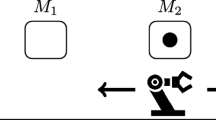Abstract
We present a general analysis of the problem of sequencing operations in bufferless robotic cell flow shops with parallel machines. Our focus will be cells that produce identical parts. The objective is to find a cyclic sequence of robot moves that maximizes the steady state throughput. Parallel machines are used in the industry to increase throughput, most typically at bottleneck processes having larger processing times.
Efficient use of parallel machines requires that several parts be processed in one cycle of robot movements. We analyze such cycles for constant travel-time robotic cells. The number of cycles that produce several parts is very large, so we focus on a subclass called blocked cycles. In this class, we find a dominating subclass called LCM Cycles.
The results and the analysis in this paper offer practitioners (i) guidelines to determine whether parallel machines will be cost-effective for a given implementation, (ii) a simple formula for determining how many copies of each machine are required to meet a particular throughput rate, and (iii) an optimal sequence of robot moves for a cell with parallel machines under a certain common condition on the processing times.
Similar content being viewed by others
REFERENCES
Agnetis, A., "Scheduling no-wait robotic cells with two and three machines," European Journal of Operational Research, 123, 303–314 (2000).
Agnetis, A. and D. Pacciarelli, "Part sequencing in three machine no-wait robotic cells," Operations Research Letters, 27, 185–192 (2000).
Blazewicz, J., H. Eiselt, G. Finke, G. LaPorte, and J. Weglarz, "Scheduling tasks and vehicles in a flexible manufacturing system," Internat. J. Flexible Manufacturing Systems, 4, 5–16 (1991).
Brauner, N. and G. Finke, "On a conjecture about robotic cells: New simplified proof for the three-machine case," INFOR, 37, 20–36 (1999).
Che, A., C. Chu, and F. Chu, "Multicyclic hoist scheduling with constant processing times," IEEE Transactions on Robotics and Automation, 18(1), 69–80 (2002).
Chen, H., C. Chu, and J. Proth, "Cyclic scheduling with time window constraints," IEEE Transactions on Robotics and Automation, 14(1), 144–152 (1998).
Crama, Y., V. Kats, J. van de Klundert, and E. Levner, "Cyclic scheduling in robotic flowshops," Annals of Operations Research, 96, 97–124 (2000).
Crama, Y. and J. van de Klundert, "Cyclic scheduling of identical parts in a robotic cell," Operations Research, 6, 952–965 (1997).
Dawande, M., C. Sriskandarajah, and S. Sethi, "On throughput maximization in constant travel-time robotic cells," Manufacturing and Service Operations Management, 4(4), 296–312 (2003).
Hall, N. G., "Operations research techniques for robotic systems," in S. Y. Nof (ed.), Handbook of Industrial Robotics, 2nd edition, John Wiley and Sons, 1999.
Hall, N. G., H. Kamoun, and C. Sriskandarajah, "Scheduling in robotic cells: Classification, two and three machine cells," Operations Research, 45, 421–439 (1997).
Hall, N. G., H. Kamoun, and C. Sriskandarajah, "Scheduling in robotic cells: Complexity and steady state analysis," European Journal of Operational Research, 109, 43–63 (1998).
Hall, N. G., C. Potts, and C. Sriskandarajah, "Parallel machine scheduling with a common server," Discrete Applied Mathematics, 102, 223–243 (2000).
Kats, V. and E. Levner, "Cycle scheduling in a robotic production line," Journal of Scheduling, 5, 23–41 (2002).
Kumar, S., N. Ramanan, and C. Sriskandarajah, "Maximizing throughput in large robotic cells," IIE Transactions (to appear).
Lei, L. and T. J.Wang, "Determining optimal cyclic hoist schedules in a single-hoist electroplating line," IIE Transactions, 26(2), 25–33 (1994).
Levner, E., V. Kats, and V. Levit. "An improved algorithm for cyclic flowshop scheduling in a robotic cell," European Journal of Operational Research, 97, 500–508 (1997).
Logendran, R. and C. Sriskandarajah, "Sequencing of robot activities and parts in two-machine robotic cells," Int. J. Prod. Res, 34(12), 3447–3463 (1996).
Perkinson, T., P.McLarty, R. Gyurcsik, and R. Cavin, "Single-wafer cluster tool performance:An analysis of throughput," IEEE Transactions on Semiconductor Manufacturing, 7, 369–373 (1994).
Pinedo, M., Scheduling: Theory, Algorithms, and Systems. Prentice Hall, Englewood Cliffs, New Jersey, 1995.
J. Blazewicz, and W. Kubiak, "Sequencing of parts and robot moves in a robotic cell," Internat. J. Flexible Manufacturing Systems, 4, 331–358 (1992).
Sriskandarajah, C., N. G. Hall, and H. Kamoun, "Scheduling large robotic cells without buffers," Annals of Operations Research, 76, 287–321 (1998).
Author information
Authors and Affiliations
Corresponding author
Rights and permissions
About this article
Cite this article
Geismar, H.N., Dawande, M. & Sriskandarajah, C. Robotic Cells with Parallel Machines: Throughput Maximization in Constant Travel-Time Cells. Journal of Scheduling 7, 375–395 (2004). https://doi.org/10.1023/B:JOSH.0000036861.28456.5d
Issue Date:
DOI: https://doi.org/10.1023/B:JOSH.0000036861.28456.5d




